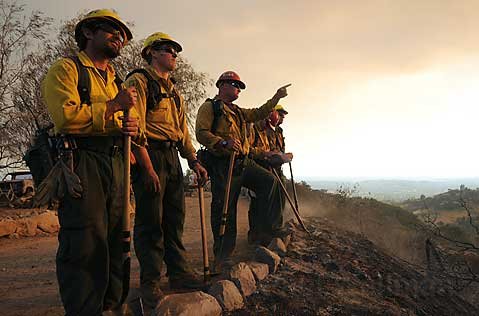Fuel Break Squabble
Los Padres ForestWatch and Forest Service Fight Over Wildfire Prevention

Are sage sparrows, blue-gray gnatcatchers, and other songbirds standing in the face of wildfire protection? That’s what Los Padres National Forest officials fear, having been hit with the threat of a lawsuit last week over the annual timing of brush clearing atop Camino Cielo, where a 40-mile-long, 300-foot-wide fuel break lines the mountaintops as a defense against the next big blaze.
“It’s just like the trails: If we don’t maintain them they will disappear,” said Los Padres spokesperson Andrew Madsen, who explained that, while this year’s work is already done, the “notice of intent to sue” is a “shot across the bow” for next year’s plans. “We don’t want to lose [the fuel-break lines]. They are very important firefighting tools in the event we get something going on top of the hill.”
That notice came from the nonprofit advocacy group Los Padres ForestWatch, whose executive director, Jeff Kuyper, said that the Forest Service is violating the Migratory Bird Treaty Act by clearing brush when certain species are nesting. “It’s unlawful for anyone, whether a federal agency, a state agency, or a private individual, to destroy nests or eggs of migratory birds,” explained Kuyper, who’s not opposed to the fuel breaks, just to the timing of the work. “Several species occur in the project area of this fuel break.”
First approved in 2002 for the ridgelines from Romero Saddle to Refugio Pass, the Camino Cielo Defensible Fuel Profile Zone project was boosted with federal stimulus funds in 2009, when the clearing contract was awarded to the Idaho-based company Environmental Forestry. In 2010, biologists with the Forest Service determined that brush clearing could safely happen anytime other than May 1 to July 10. But citing the best available science, standards for the state Department of Fish & Game and the County of Santa Barbara, and the Forest Service’s own 2006 clearing plan for the Ojai area, ForestWatch advised that the nesting season for eight “high-priority” species and another 14 protected species actually extends from mid February through late July.
“To no avail, the Forest Service has just continued with its initial conclusion,” said Kuyper, who’s also seen evidence that the clearing project is not protecting the rare plants it’s supposed to. “It seems like the Forest Service is not relying on accurate information or they think they are above the law, but the fact of the matter is that they need to follow the law. It doesn’t seem like too much to ask them to avoid certain times of the year for certain types of projects.”
But for the Forest Service, this request from Kuyper is just the latest in a long line of threats and lawsuits that only make day-to-day work increasingly challenging for the already underfunded, understaffed agency. “He sends more stuff than we can even deal with. It just slows us down,” said Madsen. “We’re playing catch up all the time with projects that were, in one way or another, held up by him.”
And Madsen’s ready to let the public know that their taxes are being diverted to deal with this form of advocacy. “This is part of our ongoing relationship with ForestWatch,” said Madsen. “Does this make you feel more safe? I know if I owned a home up in Mission Canyon, I might want to have some input on this. This potentially has a great impact on a number of folks who live and work in these areas.”
But Kuyper said that ForestWatch only uses litigation “sparingly…as a last resort,” that the work on East Camino Cielo — which is above Mission Canyon and most of the developed parts of the South Coast — is already complete, and that this letter was prompted by work on more remote portions of West Camino Cielo. “We’re not saying that the project can’t proceed,” said Kuyper, who does have other concerns about the project’s impact on rare plants. “We’re just saying that … it’s not appropriate to do that clearing during bird nesting season. That’s what the law says, and that’s what some of the region’s leading bird experts say.” Kuyper concluded, “I don’t know why they’re not doing what every other agency in this area does and has been doing for years.”



